Nothing brings wintertime operations to a halt faster than a frozen and blocked pipe. When industrial and residential pipes freeze, flow stops, expensive equipment breaks, surrounding items are damaged, valuable product is lost, and repair downtime begins. Even if the pipe’s contents have a lower freezing point, changes in viscosity can cause catastrophic damage.
Applying insulation and other heating solutions before the winter months begin, saves you time, money, and frustration all winter long.
Why Heat and Insulate Pipes?
Freeze Protection
Sub-freezing temperatures cause solids, liquids, and gases to behave in different ways. Solids become more brittle and vulnerable to breakages. Liquids increase in viscosity, freeze solid, and expand. Gases settle, lose pressure, and form detrimental blockages like hydrates.
Maintain Pipe Flow
Even slight viscosity changes within the contents of a pipe significantly reduce flow rates. This reduction in flow creates internal build-up around pumps, valves, junctions and corners. Reliable and consistent heat and insulation keep pipe contents flowing smoothly and protect the viability of your product.
Improve Personnel Safety
No matter their contents, burst pipes can create an extremely unsafe work environment. Pressurized explosions, frozen puddles, hazardous vapors and gases, debris, and more can all be avoided with the careful application of pipe heating and insulation.
Prevent Product Loss
Unheated and un-insulated pipes are much more likely to leak, break, and burst. Even a small pipe crack can result in hundreds of gallons of lost product every minute. That product loss only increases in more remote areas where leaks and blockages can go unnoticed for longer. Pipe heating solutions are an effective insurance measure to protect you from future product loss.
Avoid Costly Downtime
For many industries, the winter months already represent a decrease in business operations. With the addition of preventable pipe damage, those operations can come to a complete standstill while repairs are made and flow is restored. Don’t let Jack Frost steal another minute of your operation’s time. Insulative pipe heating will reduce winter maintenance costs and keep your pipes running all winter long.
Protect Valuable Equipment
Un-heated and un-insulated pipes can cause problems all down the pipeline. Sometimes those problems are not detectable until they affect valuable access points like pumps, tanks, and valves.
Pipe Heating and Insulating Options: Pros and Cons
Trace Heating
Trace heating is a surface treatment where lines of heat are applied to the piping’s exterior. These lines can take many forms: electric tape, mineral insulated cables, steam, glycol, or even hot oil. Depending upon the pipe length, some heat trace installations require additional heating circuits and control access points. Most trace heating systems turn on with a simple on/off switch. Trace heating is sometimes combined with insulation to reduce heat loss.
Pros:
Some operations are initially attracted to trace heating by initial costs and convenience.
Cons:
Trace heating may look like an inexpensive heating option at first, but long term costs build up. Installing heat tracing is time consuming and very difficult to remove for pipe maintenance and inspections. Bare trace heating also loses a lot of heat into the ambient air and requires extra insulation in order to reduce temperature loss.
Most heat trace applications operate with a simple on/off switch and provide little control over temperature ranges or heating schedules. Electric trace heating also typically needs to be re-installed every 3 years to reduce the risk of fire hazard.
Space Heaters
Pros:
Because space heaters are fairly ubiquitous, it is extremely easy to find one in case of an emergency.
Cons:
Space heaters heat the whole room or space instead of just the pipe, leading to higher energy costs. Because the heat source is not in direct contact with the pipe, they do not heat as effectively as other methods.
Insulation Jackets/Blankets
Pipe insulation jackets or blankets are typically made of foam, fiberglass, or mineral wool. They wrap securely around pipes that are in locations that require freeze protection (like un-insulated exterior walls and outdoor operations).
Pros:
Insulation jackets help conserve energy by trapping already existing heat against the pipes, thus reducing heating costs. They are also very effective noise reducers in areas with a high concentration of piping.
Cons:
Under extreme winter conditions, insulation alone is not enough. Even if the pipe’s contents self-generate some heat, the risk of viscosity problems and blockages increases with every degree lost.
Heated Insulation Jackets
Just as the name says, heated insulation jackets or blankets act as both a heat source and insulation.
Pros:
These jackets have external insulation to direct heat inward to the pipes instead of wasting energy heating the ambient air. They also are able to provide additional heat when the temperatures plunge. Heated insulation jackets are typically very easy to install and remove in case of possible pipe maintenance.
Pipe Heating: Things to Consider
There are many factors to take into consideration when preparing your piping for the arrival of winter.
Installation Time
Keep in mind that however long it takes to install heating, it will take at least that long to remove it if you ever need to change your pipe layout, make repairs, or conduct routine safety inspections.
Cost (Initial vs. Long Term)
Carefully weigh initial and long term costs when comparing pipe heating solutions. Will cheap heating solutions save you time and money down the road? Or will they lead to higher energy usage, waste heat, larger utility bills, and reinstallation costs? Heating solutions should be considered a multi-year investment and should be viewed through a long term lens.
Pipe Maintenance/Inspection
Consider routine pipe maintenance and safety inspections into your heating plan. Make sure your pipes are accessible and your heating system is as flexible as you need to be.
Temperature Control
Imagine your wall thermostat only operating with a simple on/off switch with no control over temperature ranges. You would spend most of your time babysitting that switch to keep your temperatures where you need them. Consider how much time, energy, and manpower you would like to devote to heating maintenance. Choose a pipe heating solution that gives you the amount of control you need to keep your pipe temperatures where they need to be.
Safety
Depending upon the contents of your pipes, your heating solution may need extra safety certifications to reduce fire risk. For hazardous locations with the risk of exposure to flammable gases, make sure your heating solution is properly rated.
Heat Loss/Surface Contact
The closer your heat source is to your pipes, the more efficiently it will transfer heat. Similarly, more surface contact between your heat solution and your pipes will reduce waste heat and unnecessarily high utility costs.
Pipe Location and Environment
Are your pipes in an exterior location? If so, you will need to ensure your pipe heating solution will hold up to inclement weather, moisture, debris, and other environmental hazards.
Powerblanket Custom Pipe Heating and Insulating Solutions
Powerblanket insulated pipe heaters provide you with the protection of insulation with the power of direct, even heating. Our patented heat distribution system is encased in a heavy duty vinyl exterior jacket, that is extremely easy to install and remove for maintenance. With options for C1D2 hazardous certifications and smart thermostatic controls, we can provide you peace of mind all winter long. We are proud to offer the fastest customization process on the market, and will engineer a pipe heating solution contoured to your exact layout. Contact us today to find the perfect pipe insulating and heating solution for your needs at 866.957.5538 or [email protected]
Pipe heaters from Powerblanket keep your fluids flowing all year long, providing freeze protection for your entire system.




